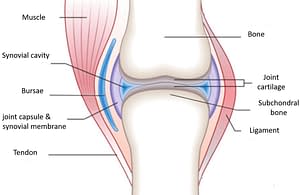A joint is the point of connection between two (or more) bones. There are different types of joints, which have varying degrees of mobility. The knee, shoulder, hip and fingers are very movable joints, while the vertebrae are less movable, and the joints of the skull are immovable. The tolerated movements of the skeleton are delimited by the presence of ligaments, which connect the two bones and surround the joint capsule. The various movements are produced by the action of the muscle contracting and pulling on the tendon that attaches muscle to bone. Bursae facilitate the gliding motion between the various structures. They provide lubrication and absorb shock at pressure points of the bones, tendons and muscles near a joint.
The end of each bone is covered in a thin layer of articular cartilage, a pad of well-lubricated, smooth, elastic tissue. The space between the two cartilaginous ends contains synovial fluid, a clear, viscous fluid that serves to reduce friction by lubricating the joint and to absorb shock. Since cartilage is not vascularised, the synovial fluid also supplies oxygen and nutrients to the chondrocytes (cells) in the cartilage, eliminates metabolic waste, and contains phagocytes which destroy debris and microorganisms. The cartilage also receives nutrition via the subchondral bone, a layer binding bone to cartilage. It also supplies stem cells and structural molecules to the cartilage.
Disclaimer of liability:
The information published on www.swiss-alp-health.ch does not claim to be complete and is not a substitute for individual medical advice or treatment. It cannot be used as an independent diagnosis or to select, apply, modify or discontinue treatment of a disease. In case of health problems, it is recommended to consult a doctor. Any access to www.swiss-alp-health.ch and its contents is at the user’s own risk.


